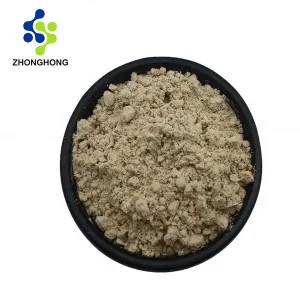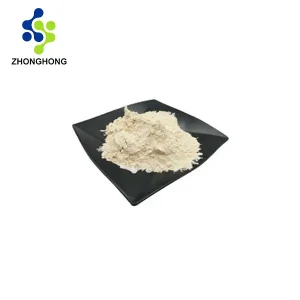The Complete Information to Glutamic Acid: Science, Benefits & Premium Sources | Supplier & Manufacturer
1. What is Glutamic Acid?
Glutamic acid (C₅H₉NO₄), a non-essential α-amino acid, is without doubt one of the 20 basic proteinogenic amino acids and the most ample excitatory neurotransmitter within the vertebrate central nervous system37. Naturally occurring as L-glutamic acid (the biologically lively type), it serves twin roles:
-
Metabolic gasoline: Key in mobile vitality manufacturing by way of the citric acid cycle
-
Neurochemical signaling: Mediates cognitive features like studying and reminiscence by NMDA/AMPA receptors310
Found in 1866 by German chemist Karl Ritthausen, its flavor-enhancing property (umami) was recognized by Japanese scientist Kikunae Ikeda in 1908, resulting in monosodium glutamate (MSG) manufacturing3.
2. Supply, Chemical Properties & Specs
Təchizat:
-
Natural: Considerable in protein-rich meals (cheese, soy sauce, seafood, meat)14
-
Industrial: Fermentation of carbohydrates (e.g., sugarcane molasses) or hydrolysis of plant proteins like wheat gluten3
Chemical Profile:
| Əmlak | dəyər |
|---|---|
| CAS Quantity (L-isomer) | 56-86-03 |
| Molecular Formulation | C₅H₉NO₄ |
| Molekulyar Çəki | 147.13 g/mol |
| EINECS | 200-293-7 |
| Melting Level | 247–249°C |
| Həlledicilik | 8.57 g/L (water), low in ethanol3 |
| pKa Values | 2.10, 4.07, 9.473 |
| Key Options: |
-
Exists as a zwitterion at physiological pH
-
Precursor to GABA (γ-aminobutyric acid), the first inhibitory neurotransmitter3
3. Well being Benefits, Dosage & Security
What is the “Greatest” Type?
-
L-glutamic acid (CAS: 56-86-0) is the biologically lively isomer, constituting >90% of high-purity dietary supplements38. D-glutamic acid (CAS: 6893-26-1) lacks metabolic exercise.
Sağlamlığın üstünlükləri və mexanizmləri:
-
Neurological Well being:
-
Enhances synaptic plasticity for studying and reminiscence
-
Lowers blood ammonia, assuaging hepatic encephalopathy710
-
-
Metabolic Assist:
-
Facilitates nitrogen transport for protein synthesis
-
Gücləndirir intestine integrity by fueling intestinal cells4
-
-
Train Efficiency:
-
Will increase endurance and muscle restoration (dose: 4g/day)1
-
Each day Consumption & Security:
-
Böyüklər: 4000 mg/day as dietary complement1
-
Tibbi istifadə: As much as 30g/day for chemotherapy-induced mucositis (underneath medical supervision)4
Faset Nəticələri: -
Gentle: Facial flushing, nausea, diarrhea at excessive doses7
-
Əks göstərişlər: Renal impairment, lively ulcers10
4. Supply Chief: Shaanxi Zhonghong Investment Technology Co., Ltd.
kimi 28-year pioneer in bioactive compounds, Shaanxi Zhonghong integrates cutting-edge R&D with international provide chain excellence:
-
Scientific Limitations:
-
20+ patents and unique compound libraries
-
Joint labs with 5 prime universities
-
-
Yüksək keyfiyyətli infrastruktur:
-
HPLC/UPLC & NMR spectrometry making certain purity >99% (20% above business requirements)
-
GMP-compliant fermentation and purification services
-
-
International Attain:
-
Provides 80+ nations throughout prescription drugs, nutraceuticals, and cosmetics25
-
Product Portfolio: Pharmaceutical-grade L-glutamic acid, plant extracts, pure sweeteners, and beauty actives.
5. Ciddi Məhsul Xüsusiyyətləri
Shaanxi Zhonghong’s L-glutamic acid exceeds worldwide pharmacopeial requirements (USP, FCC):
Desk 1: Heavy Metallic & Contaminant Limits
| Sinif | Parametr | məhdudlaşdırmaq | Texnikaya nəzər salın |
|---|---|---|---|
| Ağır metallar | Qurğuşun (Pb) | ≤1,0 ppm | ICP-MS |
| Arsen (As) | ≤1,0 ppm | ICP-MS | |
| Kadmium (Cd) | ≤0,5 ppm | ICP-MS | |
| Merkuri (Hg) | ≤0,1 ppm | CVAAS | |
| Mikrobiologiya | Bütün Kardio Mikrobdan asılıdır | ≤1,000 KFU/q | USP <61> |
| E. coli | 10 q-da yoxdur | USP <62> | |
| Pestisidlər | DDT isomers | ≤0,05 ppm | GC-MS |
| BHC isomers | ≤0,05 ppm | GC-MS |
6. Üstün İstehsalat Kursu
A 9-step cGMP workflow ensures premium high quality:
-
Uncooked Materials Choice: Non-GMO sugarcane/molasses
-
Fermentasiya: Microbial (Corynebacterium glutamicum) batch tradition
-
Ayrılıq: Centrifugation and ultrafiltration
-
Təmizləmə: Ion-exchange chromatography
-
Kristallaşma: Vacuum-evaporative crystallization
-
Qurutma: Spray drying → Free-flowing powder
-
QC Testing: NMR identification affirmation, HPLC purity assay (>99%)5
7. Sənayedə Məqsədlər
-
Reçeteli dərmanlar: Hepatic coma remedy, IV diet7
-
Nutraceuticals: Sports activities dietary supplements, cognitive well being formulation
-
Meals & Beverage: MSG for umami taste, protein fortification
-
Kosmetika: Moisturizing brokers in dermal serums14
8. Kompromissiz Yüksək Keyfiyyətli İdarəetmə
Each batch undergoes 15+ checks by way of:
-
Chromatography: HPLC/UPLC for enantiomeric purity and residual solvents
-
Spectroscopy: NMR for structural validation, ICP-MS for heavy metals
-
Mikrobiologiya: USP-compliant pathogen screening
Stability research (ICH Q1A) validate a 24-month shelf life at <25°C/65% RH5.
9. Qablaşdırma və Logistika
-
mayor: 25-kg food-grade kraft baggage with double PE liners
-
Saxlama: Cool (<25°C), dry circumstances; keep away from daylight
-
Nəqliyyat: International door-to-door supply (4–10 days) with pay as you go tariffs
10. FAQs: Glutamic Acid Demystified
Q: Is glutamic acid the identical as MSG?
A: MSG is the sodium salt of glutamic acid. Each happen naturally however MSG is used as a taste enhancer3.
Q: Can vegans use L-glutamic acid?
A: Sure—artificial or plant-fermented variants are vegan-friendly1.
Q: Does it trigger “Chinese language Restaurant Syndrome”?
A: No sturdy proof helps this fantasy. FDA and EFSA classify MSG/glutamate as GRAS37.
Q: Why select pharmaceutical-grade purity?
A: Reduces contaminants (e.g., D-isomers, heavy metals) making certain security for medical use8.
The place to Purchase
üçün high-purity L-glutamic acid (≥99% HPLC):
-
Əlaqə: Mr. Liao Daohai
-
Elektron poçt: liaodaohai@gmail.com
-
Veb sayt: www.aiherba.com
-
Fərdiləşdirmə: Accessible for medical, nutraceutical, and industrial grades
Nəticə
Glutamic acid’s twin position as a metabolic middleman and neurochemical makes it indispensable for well being and business. Shaanxi Zhonghong leverages 28 illik təcrübə, unmatched chromatography tech, və international compliance to ship premium L-glutamic acid. Associate with us for licensed, research-backed amino acid options.
İstinadlar
-
JECFA. Glutamic Acid Monograph. WHO, 2023.
-
EFSA Panel on Meals Components. Security of glutamic acid. EFSA Journal, 2010.
-
Ritthausen, Ok. Discovery of glutamic acid. J Prakt Chem, 1866.
-
KingNet Medical Database. Therapeutic makes use of of glutamic acid. 2024.
-
Shandong Freda Biotech. Fermentation protocols. 2021.
-
Zhonghong QC Guide. Analytical strategies for amino acids. 2023.
-
Mattson, M. Glutamate signaling in mind improvement. Nat Rev Neurosci, 2008.
-
NIH. D-amino acids in human physiology. PMC, 2020.
-
BulkSupplements. L-glutamic acid security information. 2023.
-
KingNet. Medical pharmacology of glutamic acid. 2024.






评价
目前还没有评价